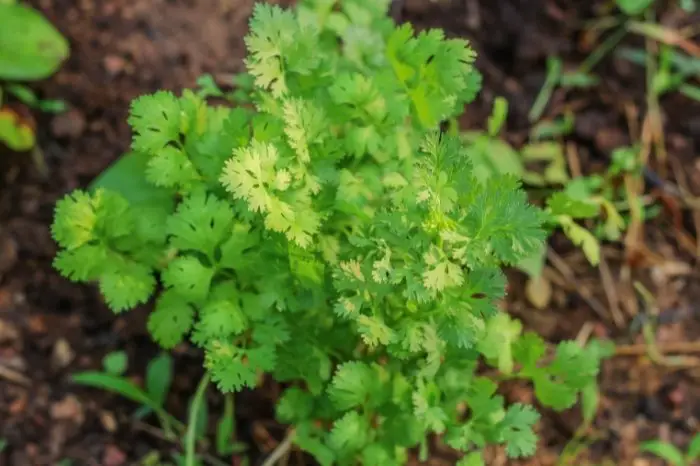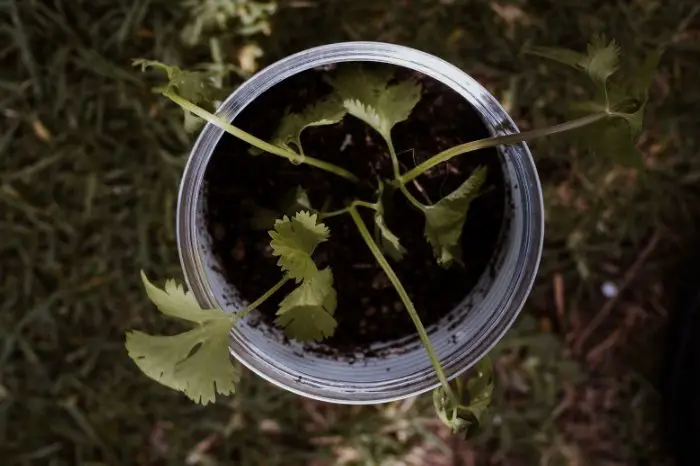Last Updated on October 28, 2022
When is cilantro ready for harvest, and what signs should you look out for to know it’s time to harvest this herb?
Cilantro herb leaf and coriander seeds grow on the same plant, also known as Chinese parsley.
It is a warm-weather annual plant popularly used in many cultures and cuisines throughout the world, especially in Indian, Asian, Middle Eastern, Mexican, Indian, Chinese, Mediterranean, and many more.
Cilantro is easy to grow without requiring any special care or attention.
When Is Cilantro Ready To Harvest?
It is possible to harvest your cilantro 4 weeks after starting your seeds. Your cilantro plants will be at least 6 inches tall by this time and ready for pinching off the outer larger leaves or cutting them with a pair of scissors. If you choose to cut them, use a pair of scissors or your hands to snip the stem about an inch off the soil’s surface.
Depending on how much cilantro you need for your cooking, pinch a few leaves individually or harvest them in larger quantities. Harvest about ¼ to 1/3 of the leaves to allow new growth and development for continuous production!

This is important if you are growing only a few cilantro plants, and you need to make sure they grow back new leaves for a few more harvests.
It takes around 120 days or 4 months from starting the seeds for the cilantro plant to begin flowering and set seed.
In this period, you can get several harvests extending throughout the spring and into the early days of summer before it gets too hot. The heat causes the plant to bolt.
Will Cilantro Grow Back After Cutting?
Cilantro grows back when you harvest it, but it does not grow back after cutting at the end of the growing season.
This annual herb reseeds itself well if you allow your plants to flower and go to seed.
In mild climates, the cilantro plant can give you 2 to 3 cycles of cilantro harvesting in one season.
How do you trim cilantro, so it keeps growing? You have two ways to do this.
Harvesting
Harvest your cilantro from the 4th week by pinching at least ¼ to 1/3 of the leaves. You will allow new growth and development for continuous production! If you are growing only a few plants, this method is best to keep your cilantro supply coming.
This method is known as the cut and come again method. It allows for multiple harvests, provided you don’t harvest too much off the plant, which may kill it.
Before the plant goes into flowering and seeding in about 120 days, you can harvest several times. You can get multiple harvests that extend throughout the spring and into the early summer before it gets too hot and the plant bolts.
Reseeding
If you allow your cilantro plant to flower and seed during its growing season, the seeds will fall off and start new seeds that will grow into fresh herbs if provided with the right growing conditions.
Should You Let Cilantro Flower After It’s Ready To Harvest?
Cilantro has a concise life cycle. It flowers in the summer after a few harvests. Once it blooms, it’s on its way to seeding and then ends the growing process.
When cilantro starts to flower, the leaves and stems become a little tough though most people still use them in their cooking.
It is fine to allow a few cilantro plants to flower to give pollinators a place in your garden. The flowers will produce cilantro seeds that can be used as a potent spice in the kitchen or be planted in the coming season.
Harvesting Coriander Seeds From Cilantro
Harvesting coriander seeds is easy and provides you with a good quality of seeds to use in your cuisines. To harvest coriander seeds, allow your cilantro plant to flower and produce green fruit, which is the seeds. Allow the seeds to turn brown and mature before harvesting them.
As the plant turns brown, cut off the seed heads and place them in a brown envelope bag. As they dry, they will fall off into the paper bag.
Sow Right Seeds – 5 Herb Seed Collection
Pack the ready coriander seeds in your pantry away from direct sunlight. Use them in curries, pickles, relishes, or to start your next season’s cilantro plants!
Why Is My Cilantro Plant Falling Over?
The cilantro plant falls over primarily due to
- Underwatering. Lack of water causes your cilantro plants to wilt and fall over. The stem loses rigidity and strength in stem cells due to a lack of moisture. Under-watering causes your plants to bolt when they are still young messing up the flavor.
- Overwatering. Too much water causes problems with cilantro plants by removing the air pockets from the soil. The plants cannot breathe without air pockets that carry water to the stem and leaves. Too much water in the roots leads to root rot. You will notice plants falling over and wilting if you overwater them.
- Exposure to Extreme Temperatures. Too much sunlight causes the cilantro to fall over and wilt. Though this plant needs about 6 hours of sunlight, too much sun causes it to wilt. Ensure your plant gets some shade during the hot summer; otherwise, it will bolt early or fall over.
- Nutrient Deficient or Grown in Poor Soils. Lack of nutrients mostly leads to plants falling off and eventually death. Feed your cilantro with low nitrogen fertilizer or organic fertilizer for proper growth.
- Diseases and Pests. Cilantro is susceptible to bacterial diseases and pests that cause the plants to fall over. Diseases like powdery mildew and damping off seriously affect these plants. Use natural pest controls to protect your plants from pests like aphids, cutworms, or leafhoppers, infestation.

How Tall Should Cilantro Be Before Harvesting?
In about 4 weeks after planting, cilantro will be at least 6 inches tall. Not all the plants are the same to have different heights.
When harvesting, start by identifying the largest outer leaves and harvest those as you wait for the younger ones to grow larger.
FAQs
How do I know when to harvest cilantro?
Harvesting cilantro at the right time can help ensure your harvest has the best flavor and texture.
Here are some tips for harvesting cilantro:
1. Pick the leaves off the stem. The stems of cilantro are thin and hollow and will break easily if picked too early. Cilantro has a strong smell when it's fresh. You can use this to your advantage by picking cilantro leaves while it's still growing and before the smell has fully developed.
2. Pick the cilantro leaves off the stem with your fingers. If you're not sure how to pick cilantro leaves off the stem, here are some tips to help: Gently pull the leaf off the stem, then twist the stem toward you and remove the leaf from the stem. Use your fingers to gently pull the leaf off the stem. If you're picking cilantro from a bunch, use the back of your hand to rub the leaves against each other, separating them from the stem.
3. You want to wait until it's a bit past the time it would start to wilt and go limp. It will last in the fridge for about a week if picked at this point. If you've got a bunch and don't know what to do with it, you can leave it on the counter and give it a good sniff to see when it smells like it's ready.
Where does it grow naturally?
Cilantro (also known as coriander) is an annual herb that grows in moist areas. It's a member of the parsley family, and you can find it growing wild in tropical and subtropical regions throughout the world.
Will cilantro grow back after cutting?
Cilantro is very forgiving. It can be pruned back severely and still come back with plenty of leaves. I usually just take the main stem off at a point just below the flower head. You can leave the lower branches if they look healthy and green. The only time I really worry about pruning back cilantro is when it's flowering. The flowers can be quite large and if you don't cut them back soon enough, they'll drop their flower heads before you get a chance to harvest the whole plant.
I have been growing cilantro for the past 2 years and it's starting to look like a weed! I started from seed. I planted it in small pots in my garden. I fertilize it with fish emulsion and water it frequently. It grows really fast! I would say it takes 3-4 weeks to get big enough to harvest. I have cut it many times and have not had any problems with it dying or anything like that.
Final Words
Cilantro is an excellent plant for your outdoor and indoor garden. When cilantro is ready to harvest, you will be ready to prepare those mouthwatering dishes using this flavorful herb.

Lory is an avid gardener who loves spending time outdoors. She is passionate about using her green thumb to create beautiful, lush gardens for her friends and family. She finds joy in tending to her garden, trimming plants, and cultivating new species. She loves to share her knowledge and experience with others who have a similar enthusiasm for gardening. Lory is a true nature enthusiast who loves to share her enthusiasm for the outdoors with all who meet her.

